
Sam Mendoza
shared a media post in group #The Most Important Thing via #The Most Important Thing
Microsoft has gone after Slack with Teams, Notion with Loop, and now, Canva with Designer. 🩸 Why does this work? Let's break down their killer strategy below 👇
Amongst the tech giants, they are the biggest threat to SaaS startups.
Let's look at Slack as a case study.
Slack was a poster child of Product-Led Growth movement. Till this day it's one of the fastest startups to go from $1M to $100M ARR, taking just over 3 years 🤯
However, in 2016, 7 years after Slack was founded, Microsoft launched Teams.
By 2019, Teams had overtaken Slack in the number of users.
In 2020, Slack didn't see the same exponential growth that collaborative tools like Zoom did. That's because Teams was rolling up customers faster than they were.
A year ago, Microsoft announced Loop. It was clearly built to be a Notion-killer. Loop's still in beta, but you can bet they will try the same strategy.
❓ 𝐒𝐨 𝐰𝐡𝐚𝐭 𝐦𝐚𝐤𝐞𝐬 𝐌𝐢𝐜𝐫𝐨𝐬𝐨𝐟𝐭 𝐬𝐮𝐜𝐡 𝐚 𝐭𝐞𝐫𝐫𝐢𝐟𝐲𝐢𝐧𝐠 𝐜𝐨𝐦𝐩𝐞𝐭𝐢𝐭𝐨𝐫 𝐟𝐨𝐫 𝐏𝐋𝐆 𝐬𝐭𝐚𝐫𝐭𝐮𝐩𝐬?
One word: bundling.
Most incumbents offer a point solution. Startups can beat them by being better or cheaper.
But Microsoft offers a suite of products. It then bundles them in a 3-step playbook:
1️⃣ Identify a hot B2B product and copy it.
Microsoft looks for startups with viral growth amongst business users. These tend to PLG companies.
Often, their copy doesn't match the original product in terms of quality. But it doesn't need to, because of the next step.
2️⃣ Add the new product to your existing bundle of products, at no cost.
Microsoft offers a single license for its Office365 and all other SaaS products.
Sure, the copied product might be less well-designed.
But when offered at no marginal cost, and distributed to its massive network of existing users, customers struggle to justify buying an alternative.
Buying a new tool at the enterprise level also means going through a long procurement, legal, and security review process. Microsoft has already jumped through these hoops.
3️⃣ Slowly ratchet up the price for the bundle over time.
Every few cycles, the price for Office365 goes up.
Again, customers find it hard to say no. They are already reliant on Microsoft Office. Now, they also use Teams instead of Slack and Zoom, Loop instead of Notion, and Designer instead of Canva.
It's almost *reasonable* to pay a higher price instead of churning. If you churn, you have to procure 10 new solutions AND train everyone to use them.
The strategy is genius. But it also feels almost anti-competitive.
It's almost a repeat of the 90s, when Microsoft used its OS dominance to crown Internet Explorer the no. 1 browser. Then too, it relied on scale and distribution instead of a better product to crush competitors like Netscape.
What do you think? How can startups respond to this strategy? #The Most Important Thing

